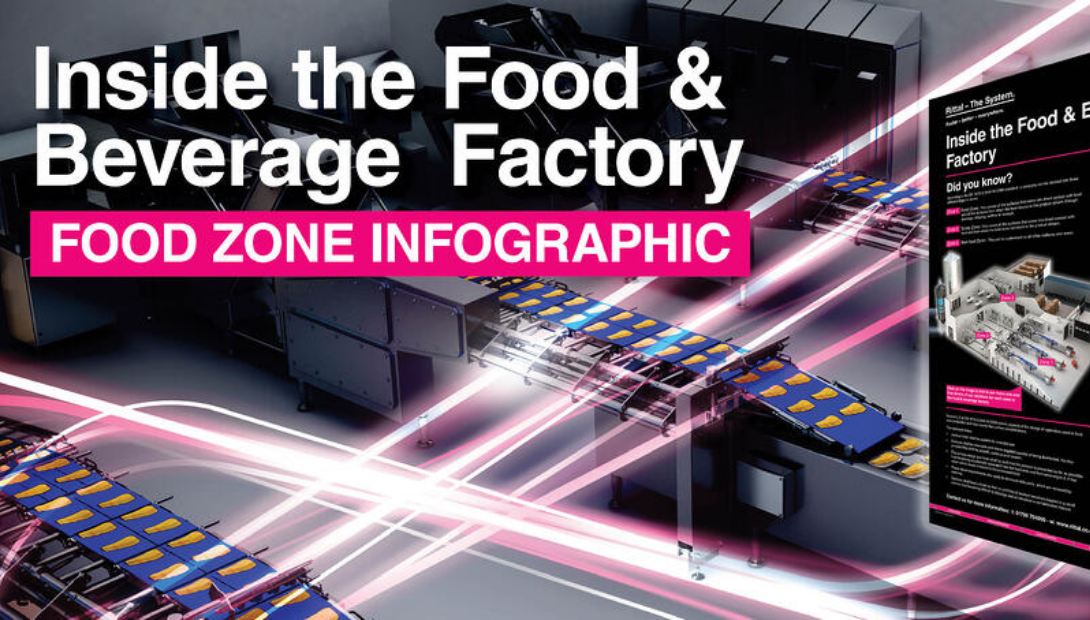
Are you using the best solution for each hygiene zone?
ZONE 1: FOOD ZONE - High Hygiene Zone
Of all the zones, the food preparation zone is the most critical. Due to the high risk of contamination, it is essential that the enclosures within this space are designed according to very strict hygiene rules.
Solution: Hygienic Design cabinets
Hygienic Design guidelines state that materials must, among other things, be corrosion resistant and easy to clean, while all joints must be sealed, seamlessly welded or glued.
Unfortunately, many electrical enclosure systems fail to meet these requirements, and this can lead to water entering inside the control enclosures during the wash down and sanitation process. Not surprisingly, water ingress across electrical components will cause considerable damage, leading to unnecessary maintenance and repair costs as well as production downtime.
Hygienic Design enclosures have become the standard housing for electrical controls in this environment because they allow rapid cleaning, they create a sealed environment for electrical systems, and they prevent the formation of pockets of dirt.
As a powerful and multifaceted CAE system, the EPLAN Platform offers comprehensive functional support in the creation and use of device and master data, enabling you to apply and comply with international codes & standards for documentation and manufacturing. (same applies to medium hygiene).
ZONE 2: SPRAY ZONE – Medium Hygiene Zone
The risk of contamination in this zone is lower than in the high hygiene zone. Here, the food is already packaged or undergoing further sterilization treatment; so for example, products such as milk are enclosed in pipe systems and are therefore protected from the outside environment.
However, floors are cleaned with cleaning agents so any enclosures in this area should be resistant to both corrosion and airborne chemical particles from the cleaning products.
Solution: Stainless steel enclosures
Stainless steel enclosures are ideal for use in medium hygiene zones. Cabinets constructed from this type of steel have a long life as they are resistant to water vapour, humidity and weak acids.
As always, adequate climate control for the equipment housed in the cabinets is essential.
Design flaws in air-conditioning and/or high ambient temperatures can lead to components overheating, resulting in repair costs and loss of revenue. With thermal design, this can be detected and remedied already in the design phase. Thermal Design Integration is a standard feature within EPLAN Pro Panel and provides engineers with the necessary visual assistance.
Once specified, climate control units (also made of stainless steel) will manage the temperatures within an enclosure, thereby reducing energy consumption and extending electrical component life.
ZONE 3: NON-FOOD ZONE - Basic Hygiene Zone
In low hygiene zones, the risk of contamination of food and beverage products is minimal, for example in the IT area or the offices within a factory. Needless to say, enclosures within these spaces do not have to comply with specific hygiene rules.
Solution: Edge IT Solutions
The ever-increasing amount of data gathered from processing equipment’s diagnostic and IoT devices means there is a rising demand for fast data processing, as close to the source as possible. Edge data centers can handle a wide variety of tasks, and will assist organisations with critical processes - such as data capture and monitoring production processes - while providing scalability and resilience benefits to users.
Edge data centre enclosures can be tailored to the specific industrial application if there is any risk to their internal electrical components. For example, on a busy shop floor, the enclosure may need to have a high Ingress Protection (IP) rating to avoid dust particles fouling up the system.
Want to find out more?
We've produced a number of informative guides to help you with your Food & Bev production areas and equipment. Choose between the 'Hygienic Design Food Zones' infographic and 'Hygienic Design for Enclosures' white paper below.


